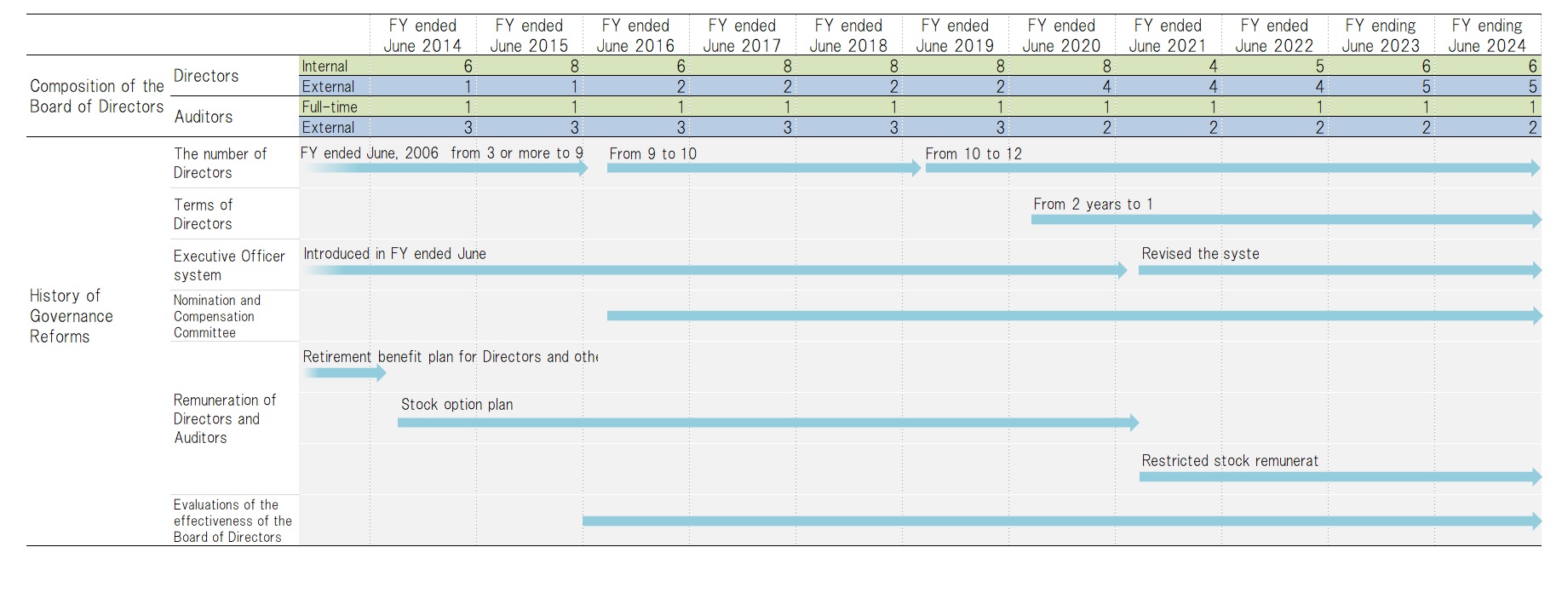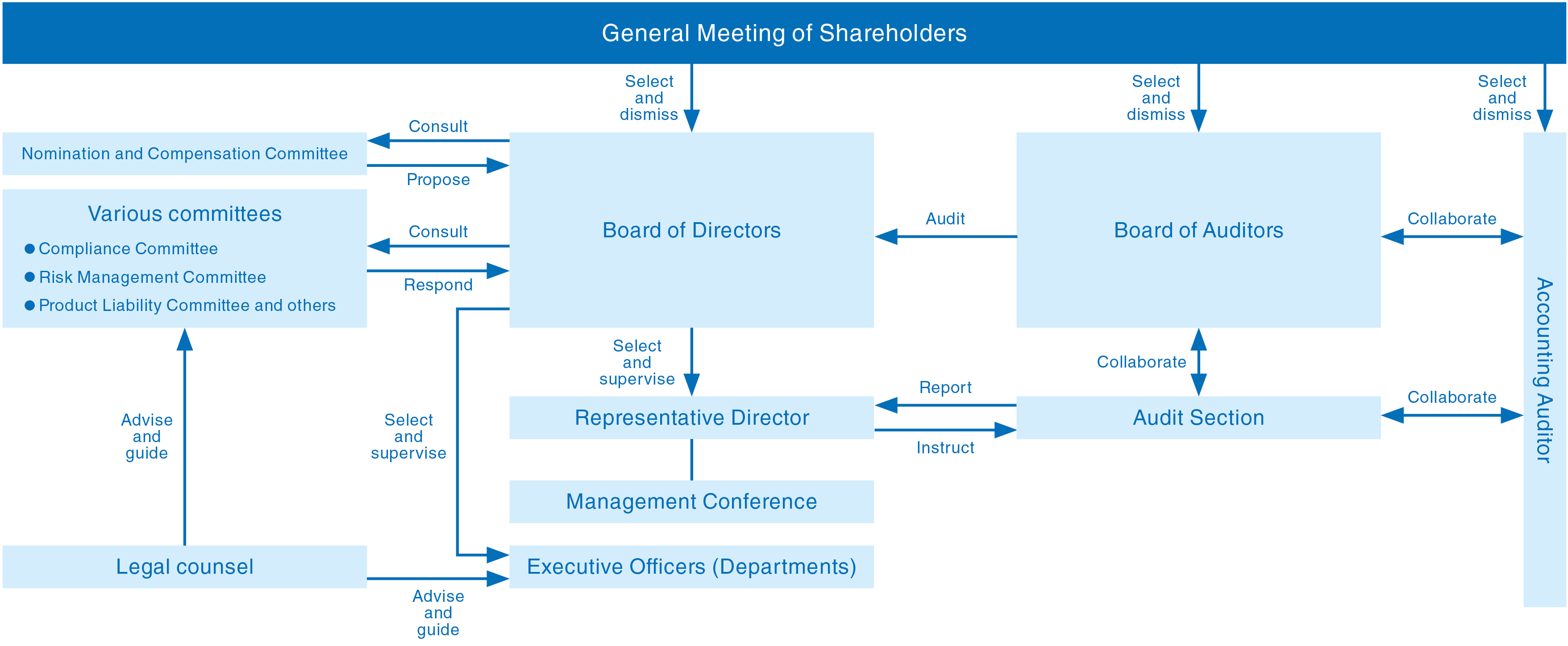Basic Approach to Corporate Governance
The Company’s basic approach to corporate governance is to conduct sound management that is highly fair and transparent, with a view to continuously increasing corporate value. To that end, the Company is working to enhance corporate governance.
The Company’s Management Philosophy is “DEVELOPING ORIGINAL PRODUCTS AND CREATING A NEW CULTURE TO CONTRIBUTE TO SOCIETY.” Furthermore, the Company’s Guidelines for Action, which are listed below, set forth how the Company should act toward its stakeholders (customers, employees, shareholders, and society) and have been clearly defined as guidelines for officers and employees.
<Guidelines for Action>
Locate Markets, Rethink Customs, and Find New Ways of Thinking
Regarding Our Customers:
Our products and our services must fully satisfy our customers. We must develop new products through creative planning to open new markets. Product quality must be maintained consistent with the standards demanded by our customers and pricing must be appropriate.
Regarding Our Employees:
A working environment must be maintained in which the capabilities of our employees are brought to life, abilities are developed while respecting the individuality of the employee, and proposals and ideas can be freely and frankly expressed. Treatment of our employees must be fair and appropriate, and must correspond to their skills and achievements.
Regarding Our Shareholders:
Information must be disclosed in a positive fashion so that we may always gain the trust and understanding of our shareholders. We must strive to expand the value of our company and return profits to our shareholders. We must strengthen corporate governance and operate under management that demonstrates a high degree of fairness and transparency.
Regarding Society:
Our products must be such that they can contribute to the advancement of culture. We must further develop our internal compliance system, and maintain our consciousness and morality as a member of society. Through our products and corporate activities, we must always strive to protect the environment and our resources.
Quick Reference Table for Corporate Governance
| Institutional design |
Company with a Board of Auditors |
| Directors (of which, External Directors) |
11 (5) |
| Auditors (of which, External Auditors) |
3 (2) |
| Terms of Directors |
1 year |
| Adoption of Executive Officer system |
Yes |
| Number of Board of Directors meetings (Fiscal year ended June 2023) |
13 |
| Number of Board of Auditors meetings (Fiscal year ended June 2023) |
12 |
| Advisory body to the Board of Directors (voluntary committee) |
Nomination and Compensation Committee |
| Remuneration structure for Directors and Auditors |
❶Basic remuneration (Fixed remuneration)
❷Performance-linked remuneration
❸Non-monetary remuneration |
| Accounting Auditor |
KPMG AZSA LLC |
Outline of the Corporate Governance Structure
The Company has chosen the structure of a company with a board of auditors and has appointed 11 Directors (5 of whom are External Directors) and 3 Auditors (2 of whom are External Auditors), as part of efforts to enhance corporate governance. To clarify the Directors’ management responsibilities further, the terms of Directors have been set at one year. With five External Directors, the Company has increased the ratio of External Directors in the Board of Directors, thereby strengthening the corporate governance structure.
Changes in the Corporate Governance Structure
Board of Directors
The Board of Directors meets once a month, as a rule. Guided by the Company’s Management Philosophy of “DEVELOPING ORIGINAL PRODUCTS AND CREATING A NEW CULTURE TO CONTRIBUTE TO SOCIETY,” the Board of Directors deliberates on various matters through extensive discussions by the Directors present at meetings. They discuss the vision and feasibility, as well as risk avoidance and other aspects of various measures to improve shareholder value, such as management policies, business plans, organization, financial condition, and investment projects, along with agenda items based on the Board of Directors’ Regulations.
The Board of Directors comprises 11 members, 5 of whom are External Directors and 6 of whom are Internal Directors. The President & CEO serves as the Chair of the Board of Directors. The Management Conference is a body that conducts deliberations prior to the Board of Directors meetings. It comprises Internal Directors and additional members. The Management Conference is held once a month, as a rule, and strives to improve Board of Directors meetings.
Moreover, the Company introduced an Executive Officer system in 2003. As a result of reinforcing corporate governance and re-examining the duties and roles of Directors and Executive Officers, the Company revised its Executive Officer system on September 17, 2020, for the purpose of expediting management decision-making, enhancing business execution functions, and bolstering the Board of Directors’ supervisory functions. The Executive Officers report to the Board of Directors on the status of business execution and important matters, including operations of the Company and its subsidiaries, and the Directors and Auditors conduct supervision and audits.
Board of Auditors
The Board of Auditors meets once a month, as a rule. Since September 19, 2019, the Company has had 3 Auditors, specifically 1 Full-Time Auditor and 2 External Auditors. To monitor significant decision-making processes based on the Audit Plan, the Full-Time Auditor audits the status of execution of Directors’ duties through activities such as surveying the business execution status of internal departments and subsidiaries, viewing important documents, and attending important meetings, and reports the audit details to the Board of Auditors. In addition, the Auditors attend Board of Directors meetings and state their opinions, and also audit the methods of operation, resolutions, and deliberations of the Board of Directors, among other things. The Company’s two External Auditors are a certified tax accountant with considerable knowledge of finance and accounting, and a patent attorney with deep insight and extensive experience.
Nomination and Compensation Committee
The Company has established a Nomination and Compensation Committee as an advisory body to the Board of Directors, comprising five members, three of whom are External Directors and two of whom are Internal Directors. The committee was established to further increase the transparency of the decision-making process for the selection and dismissal of candidates for Director and Auditor, and for their remuneration. The Nomination and Compensation Committee considers matters related to the selection and dismissal of candidates for Director, Executive Officer and Auditor, as well as matters related to the remuneration of Directors, Executive Officers, and Auditors, and also determines the amounts of base remuneration and bonuses for each Director.
Corporate Governance Structure Diagram





 Environment
Environment Social
Social Governance
Governance